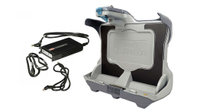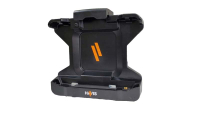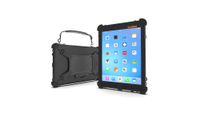Tough Enough: Tablets edition
Forget about babying these tablets because they are more than tough enough
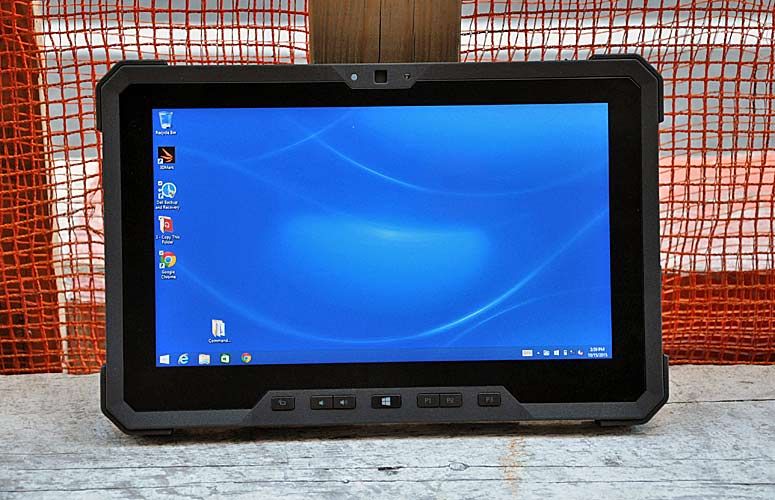
Once thought to be a dying technology, tablets are all around us. Since the pandemic, tablet sales have been on the rise and are used for everything from watching videos and paying for take-out dinners to curling up with a good book. But tablets are more than a convenient means to consume multimedia. They’re also capable of helping firemen, cops and soldiers do their jobs. But, regardless of what it’s used for, a tablet that is dropped, rained on, or shaken in the back of a car can end up being nothing more than an expensive pile of broken glass, plastics and electronic parts.
Just like Humpty Dumpty, it’s next to impossible to put a smashed tablet back together again. That’s where rugged tablets come in. Designed from the start to withstand elements and clumsy users, these devices are meant to last. Think of rugged vs. normal tablets as being akin to the difference between driving a pickup truck and an Army tank and you’ll get an idea of the potential for rugged tablets to last and last.
Strength through design
Why you can trust Laptop Mag
To achieve this, just about every aspect of a rugged tablet has been beefed up. Not only is a rugged system’s frame strengthened, but the skin is often made of magnesium-aluminum alloy and covered with soft rubber to absorb the shock of impact. The display’s glass is reinforced and any openings, for ports, microphones or speakers, are sealed against dust or water getting in.
In other words, in this rough and tumble world, only the strong survive. Those that pass the U.S military’s tests are the elite of mobile computers. They can endure just about anything that a klutzy user or aggressive off-the-grid adventurer can throw at it.
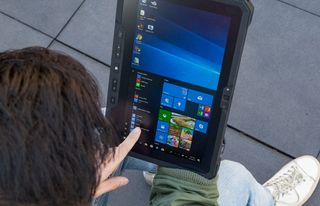
Regardless of whether they are notebooks, tablets or phones, the gold standard for rugged devices is the military’s stringent MIL-STD 810G and the newer 810H specifications. Also known as Mil-Spec, the routine consists of more than two dozen tests of strength and resilience. They define each aspect of toughness, including being dropped, shaken and rained on, frozen, baked and blasted with dust and sand. Those that pass are the iron men of computing and make ordinary tablets look weak, feeble and prone to breakage.
All this extra engineering adds up in weight and size, with the typical 10.1-inch rugged tablet weighing between 1.5 and 2.5 pounds, versus 1.1 pounds for the current 10.2-inch iPad. Going rugged can also weigh down your wallet. For example, the typical ruggedized tablet can cost over $2,500 versus about $350 for an entry-level iPad.
The tough three
To separate the marketing hype from sober reality, we gathered together three of the newest and ruggedest tablets available. They range from the diminutive Acer Enduro T1 to the midsized Panasonic Toughbook FZ-A3 to the downright heavyweight MobileDemand xTablet A1180. The one thing they have in common is the ability to survive when lesser tablets would break, get waterlogged or shake apart. We gave each a tough workout and torture test to see how they shape up.
The pay-off of going rugged is immense, particularly for those of us who are all thumbs or who absolutely must have a tablet that can endure the rigors of work. The alternative is to buy a replacement after each tablet disaster. In fact, when it comes to the difference between rugged tablets and merely mortal ones, you can pay now or later.
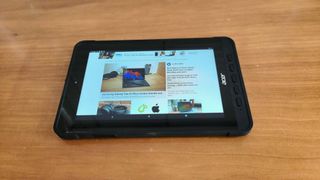
Acer Enduro T1 ET108-11A-80PZ
Our expert review:
Reasons to buy
Reasons to avoid
An alternative to traditional rugged heavyweights, Acer’s Enduro T1 ET108-11A-80PZ tablet makes a virtue of being small, light and inexpensive. It, however, lacks some of the creature comforts that buyers expect, like mobile data, an easily removable battery and a high-resolution screen. Still, it’s tough enough to survive the worst you can put it through.
Phablet sized, the dark gray Enduro T1 weighs 1.1-pounds and measures 8.9 x 5.8 x 0.4 inches, meaning that it can go places that a traditional rugged tablet with a larger screen can’t. Unlike the FZ-A3, the Enduro T1 includes a useful hand strap, making it hard to drop while using it. Acer’s new Enduro family has notebooks and tablets that use Windows 10 and have 10- to 14-inch screens.
Rather than building the Enduro T1 like a bank vault, it uses a reinforced frame, plastic case and easy-to-grip rubber edging. It feels good in the hand and the case has no flex to it.
On the other hand, the Enduro T1’s 8.0-inch screen felt cramped compared to a 10.1-inch screen on the PZ-A3 and A1180. The screen has Gorilla Glass and panel bonding eliminates the air gaps between the display’s layers. It delivered 309 nits versus about 200 nits for the typical phone or notebook screen. It was just luminous enough to be used in bright sunlight although small type was hard to read.
On the other hand, it's second-best with wide-XGA resolution of 1280 x 800 compared to the high definition imaging of the competition. The tablet has a 2-megapixel camera facing the user and a 5-megapixel one facing away.
If you enable the system’s Glove mode, it works well with a covered hand, but the Enduro T1’s petite size doesn’t allow a stylus although it worked with a generic dome pen. The system’s two programmable keys can open any app, although the FZ-A3 has five.
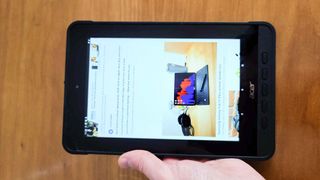
Its ports are minimalist with a USB-C connector that doubles for charging the tablet and a headphone jack. All are covered with soft rubber doors to keep the elements out. There are neither vehicle nor desktop docking stations available for the Enduro T1 at the moment, but Acer is working on them.
Powered by a MediaTek MT8385 eight-core processor that runs at up to 2GHz, the Enduro T1 has 4GB of RAM and 64GB of solid-state storage. That’s half the storage capacity of the MobileDemand xTablet A1180, but, like the others, the Enduro T1 has a micro SD card slot that can boost storage by up to an extra 512GB.
To get online, the Enduro T1 uses 802.11ac Wi-Fi (sorry, no Wi-Fi 6) but without the ability to tap into mobile data via a 4G/LTE network. There’s also Bluetooth and a Near Field Communications (NFC) chip for connecting with a door lock, printer or smart ID card.
Based on Android 9.0, the Enduro T1 handled our series of performance benchmarks surprisingly well, considering its size. With scores of 281 and 1,292, the Geekbench 5 single- and multi-processor tests, the Enduro T1 was just behind the FZ-A3’s performance in basic tasks. It took the lead in the Compute series of tests that mimic real-world operations with a score of 1,104 compared to the FZ-A3’s 631 and the A1180’s 581.
The Enduro T1 has a 4,420 mAH hour battery that lasted for 8 hours and 55 minutes while playing YouTube videos. This makes it capable of full day work or off-the-grid play. Unlike the others, you can’t quickly swap its cells for fresh ones. That said, the system’s USB-C port can get the battery to a half charge in about 45 minutes and a full charge in 1:40, according to Acer.
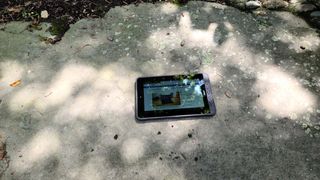
It survived our drops, spray downs, freezes and shakes, making the Enduro T1 ready for everyday use and abuse. Oddly, like the FZ-A3, the system picked up some white paint from the shake table. Fortunately, it was easy to clean off. Acer claims it meets all 810G standards, although the company used the older 810F standards for the dust and water intrusion section. It meets the IP54 intrusion standard and is impervious to limited dust and water onslaughts but is second best to the FZ-A3 and A1180.
No bigger than a paperback book and $350, the system includes a 1-year warranty that pales in comparison to the FZ-A3’s three years of coverage. As a first-generation rugged system, it may not be perfect but the Enduro T1 hits the mark more often than it misses with a rugged system that is so small, light and can go anywhere you go.
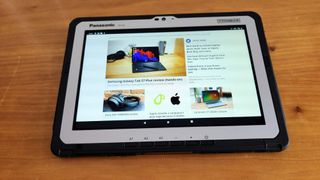
Panasonic Toughbook FZ-A3
Our expert review:
Reasons to buy
Reasons to avoid
Easily the largest maker of rugged computers, Panasonic thinks small when it comes to its Toughbook FZ-A3 tablet, a super-rugged system that should survive just about anything short of a nuclear blast. The downside for this robustness is that the FZ-A3 is expensive and heavy but has been designed and built to not let you down.
At 2.0 pounds and 10.7 x 7.6 x 0.7-inches, the FZ-A3 is several ounces lighter than the MobileDemand xTablet A1180, which also uses a 10.1-inch screen. Its textured magnesium-aluminum skin is not as inviting as the plastic case of the Enduro T1, but there is not even a hint of flex to the FZ-A3’s case. It has rounded corners and soft rubber bumpers.
Upfront, the FZ-A3’s 10.1-inch display uses reinforced Gorilla Glass that sadly showed fingerprints as soon as I started using it. It not only displayed WUXGA resolution of 1920 by 1200-resolution, but delivered an astounding 936 nits of brightness or roughly four times what the typical notebook or phone emits. This made it the best of the three in bright sunshine, meaning it’s just as good at the beach as at the top of a telephone pole.
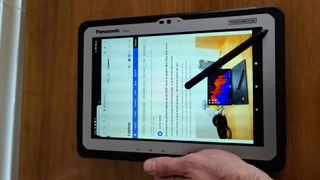
It comes with a stylus, a place to stash it, and a tether for attaching it to the system. The screen has several settings so you can configure it for your fingers, glove and use in the rain. There are cameras that are front-facing (5-megapixel) and rear-facing (8-megapixel) as well as five app buttons that can be easily changed.
The system has ports for power, USB-C, USB 3.0 Type-A and a headphone jack, each with a protective cover to keep dust and water out. The unit I evaluated included Panasonic’s xPack barcode scanner, but it could have been ordered with an extra USB port or smart card reader instead. With a Near Field Communications (NFC) chip built-in, the FZ-A3 can be used with things like a printer, ID card or door lock.
In addition to a five-bay battery charger, there is a hand strap (something Acer’s Enduro T1 and MobileDemand’s A1180 include) and a desktop cradle that yields two USB ports. There’s a growing FZ-A3 accessory ecosystem from third parties that include vehicle docking stations for the tablet made by Gamber-Johnson and Havis. They connect via the 25-pin connector on the system’s bottom edge.
Panasonic Toughbook® A3 Tablet Docking Station (DUAL RF)
with LIND 90W Auto Power Adapter
Docking Station with Dual Pass-Thru Antenna Connection
for Panasonic TOUGHBOOK A3 Tablet
Under the surface, the FZ-A3 is built around Qualcomm’s 2.2-GHz Snapdragon SDM660 processor with 4GB of RAM and 64GB of solid-state storage space, half the storage potential of the MobileDemand xTablet A1180. Under one of the batteries is a slot for adding a microSD card to augment its storage by as much as 64GB. The system has Bluetooth, 802.11ac Wi-Fi and Global Positioning System (GPS) electronics built-in. There are also two SIM card slots for connecting to a 4G/LTE network.
Based on Android 9.0, the FZ-A3 is a powerful system that satisfies most users. In addition, scores of 335 and 1,308 on the Geekbench 5.0 single- and multi-processor tests outdo the Enduro T1 and A1180. On the other hand, the FZ-A3’s 631 score was well behind the Enduro T1’s 1,103.
Rather than a single battery, the FZ-A3 has a pair of 3,200 milli-amp hour batteries that powered the tablet for 5 hours and 43 minutes, the shortest of the three ruggeds we looked at. Its saving grace is that in less than a minute you can swap a depleted battery for a fresh one. Panasonic also sells a $165 extended battery that holds 5,580mAH but adds to the unit’s thickness and weight.
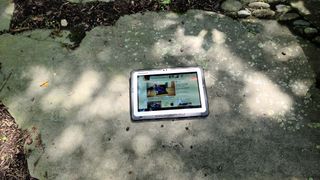
Just about bulletproof, the FZ-A3 combines the military’s 810H tests with an IP65 rating that means the unit is dustproof, watertight and can withstand prolonged water sprays, like a sudden downpour. A marvel of endurance, the FZ-A3 survived our torture tests of dropping, shaking, freezing and raining. Like the Enduro T1, the back picked up some white paint from the shake table gear, but it also took a second bounce and ricocheted off an air duct when dropped onto concrete. Just in case, it includes a three-year warranty, which should help the clumsy sleep better at night.
A unique crossover system, Panasonic’s Toughbook FZ-A3 is just as good for the military or professionals as it is for those who push the envelope of outdoor sports and the butter-fingered among us. At $2,700, it’s a lot to spend on a tablet, but with the strength to survive just about anything, it is not only our pick for the best rugged tablet but it might just be the last tablet you need to buy.
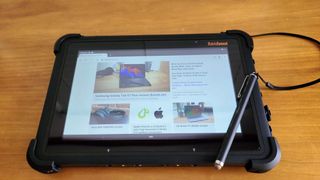
MobileDemand xTablet A1180
Reasons to buy
Reasons to avoid
By altering the traditional rugged recipe of a reinforced frame, tough skin and strengthened glass, MobileDemand successfully updates the genre with its xTablet A1180. It not only delivers a full workday of battery life, extra ports and a handle, but does so for a lot less than traditional rugged systems.
Built around a dark gray case with a heavy-duty frame and soft corner bumpers, the price for this protection is that the A1180 is a heavyweight at 2.6 pounds and 11.6 x 8.0 x 1.3 inches. That’s about one-third heavier and bigger than the FZ-A3, which also has a 10.1-inch display. On top of a full line of rugged notebooks, MobileDemand sells ten different rugged tablets that use either Android or Windows 10 software.
Like the FZ-A3, the A1180’s 10.1-inch display shows WUXGA resolution of 1920 x 1200-pixels and more detail than the Enduro T1 can muster. Rather than the Gorilla Glass used on the Enduro T1 and FZ-A3, the A1180’s display has a proprietary reinforced glass that MobileDemand says is just as strong and scratch-resistant, but also includes a removable five-layer screen protector. It worked with gloves, in the rain and delivered 456 nits, about double the brightness of a regular notebook or phone. The screen was usable in bright sunlight, but I found that angling the tablet helped.
The A1180 comes with a dome stylus, tethering cord and a sleeve to hold it in the system’s hand strap. Its 2-megapixel front-facing camera is augmented by a rear-facing 8MP cam. Underneath, the system has a single instant access button, but it only works with the MobileDemand barcode scanner and can’t be reprogrammed for new apps.
With the best set of connections in rugged tablets today, the ports go beyond the expected with a USB 3.0, a micro USB 2.0, a headphone jack and a power connector to include wired Ethernet and Micro HDMI for getting online and sending video to an external display. It lacks a USB-C connector but has Near Field Communications (NFC) and Global Positioning System electronics built-in as well as Bluetooth and 802.11ac Wi-Fi. The tablet I looked at came with MobileDemand’s 4G/LTE option, which has a SIM card under the battery but it required an adapter for my network’s nano-SIM card.
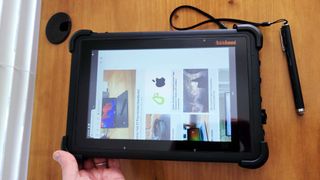
The system comes with a hand strap and a carrying handle. In addition to a barcode scanner, MobileDemand has vehicle and desktop docks that use the A1180’s 10-pin connector. All the ports have flexible doors and the system carries an IP65 rating that matches the ability of the FZ-A3 for work in a downpour or dust storm. It surpasses the Enduro T1’s IP58 rating.
The A1180 is powered by a RocketChip’s RK 3399 with six processing cores that can run at up to 2GHz. It’s backed up with 4GB of RAM and a generous 128GB of solid-state storage space – twice the level provided by the Enduro T1 or FZ-A3. Under the battery is the A1180’s microSD card slot that can boost its storage capacity by another 512GB.
It uses Android 9.0 software and had the lowest performance potential of the three systems we looked at, starting with its 248 and 649 on Geekbench 5.0’s single- and multi-processor scores. Its 581 on the real-world compute tests put it slightly behind the FZ-A3 and well behind the Enduro T1. Still, it never let me down in a week of daily use. And while the right side of the unit got quite warm, the temperature never reached above 108 degrees Fahrenheit.
Its huge 10,800 milliamp-hour battery means that the A1180 can go and go. It ran for 8 hours and 25 minutes on a charge, or half an hour behind the Enduro T1 but nearly 50% longer than the FZ-A3. The cells can be quickly swapped.
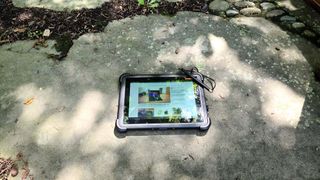
The A1180 covers the entire gamut of 810G testing and stood up to our torture tests, which included freezing it, soaking it, shaking it and dropping it three times. It didn’t even have a scratch on its case after all that torment. On the other hand, its 1-year warranty can’t compare to the Toughbook FZ-FZ-A3’s 3-years of coverage unless you spend $325 for the three-year extension.
With a starting price of $1,345 – half that of the FZ-A3 – the A1180 has an a la carte ordering menu. Figure on adding $50 for the battery and $245 for the 4G/LTE mobile option and it comes to $1,640, which is still more than $1,000 cheaper than the FZ-A3. In other words, the xTablet A1180 won’t let you down and won’t drain your checking account, either.
Protecting an iPad
While it’s the hands-down sales leader with nearly 16 million tablets sold last year, Apple’s iPad was designed more for style than ruggedness. But there is a way to defend an iPad: MobileDemand’s Rugged xCase.
Comprised of a soft silicon rubber boot with a tough ABS plastic cover, the xCase has large corner bumpers and port covers. It took less than a minute to install it over my 9.7-inch iPad; the company makes similar cases for other iPads and Surface Pros.
All told, the case added 14 ounces and about half an inch to my iPad but was ready to be dropped, shaken, rained on and more. The bonus is that, in addition to a hand strap, handle and no fewer than seven places to tether a stylus to the case, MobileDemand sells options like a magnetic mount, a vehicle kit and an easel desktop stand. If you register the case, you’ll get a five-layer screen protector.
At $40, the Rugged xCase is a luxury that clumsy iPad owners can afford.
Rugged xCase for iPad 9.7-inch
(Regularly $79.95) NOW on Sale!
More than tough enough: Three rugged tablets
| Name | Acer Enduro T1 | Panasonic Toughbook FZ-A3 | MobileDemand xTablet A1180 |
| Ruggedness ratings | Mil. Std. 810G/IP54 | Mil. Std 810H/IP65 | Mil. Std. 810G/IP65 |
| Dimensions/Weight | 8.9- by 5.8- by 0.4-inches/1.1-pounds | 10.7- by 7.6- by 0.7-inch/2.0-pounds | 11.6- by 8.0- by 1.3/2.6-pounds |
| Screen size/Resolution | 8.0-inch/1,280 by 800 | 10.1-inch/1,920 by 1,200 | 10.1-inch/1,920 by 1,200 |
| Stylus/Holder | No/No | Yes/Yes | Yes/Yes |
| Camera front/Rear | 2MP/5MP | 5MP/8MP | 2MP/8MP |
| Processor/Speed | Mediatek MT8385/2GHz | Qualcomm SnapDragon SDM 660/2,2GHz | RocketChip RK 3399/2GHz |
| RAM/Storage | 4GB/64GB | 4GB/64GB | 4GB/128GB |
| Ports/Docks available | USB C, power, headphone, micro SD/None | USB C, USB 3, power, headphone, micro SD/desktop and vehicle docks available | USB 3.0, Micro USB 2.0, micro HDMI, power, headphone, Ethernet, micro SD/desktop and vehicle docks available |
| Battery capacity/Removable | 4,420mah/No | two 3,200 milliamp-hour/Yes | 10,800 milliamp-hour/Yes |
| Price/Warranty | $350/1-year | $2,700/3-year | $1,345/1-year |
Performance Results
| Battery Life | 8:55 | 5:43 | 8:25 |
| CPU: Single/Multiprocessor | 281/1,292 | 335/1,308 | 248/649 |
| Compute | 1,104 | 631 | 581 |
| Screen brightness | 309 cd/m2 | 936 cd/m2 | 456 cd/m2 |
Testing Rugged Tablets
When it comes to rugged tablets, strength and performance go hand in hand. In that vein, we started by looking at each system, measuring, weighing and trying out their main features, including the port doors, the instant access buttons and any extra software they provide.
Next up, we gave each a thorough workout with a series of benchmarks that gauge their potential. These range from performance (with Geekbench 5.0) to screen brightness (with a Minolta LM1 light meter) to battery life (by running each system down while playing YouTube at 75 percent display brightness).
Finally, we used then side by side on a bright sunny day. Then, each tablet had to endure a torture test to prove their mettle in the real world where tablets get dropped, rained on, frozen and shaken in the back of a car. This series of tests consisted of:
- Three drops from desk height (29-inches) onto concrete, wood and carpet;
- 25 minutes at about 12 degrees Fahrenheit;
- 10 minutes on a shake table;
- 90 seconds of water spray.
Stay in the know with Laptop Mag
Get our in-depth reviews, helpful tips, great deals, and the biggest news stories delivered to your inbox.
